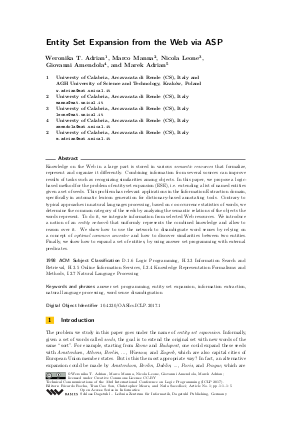Entity set expansion from the Web via ASP
Authors Weronika T. Adrian, Marco Manna, Nicola Leone, Giovanni Amendola, Marek Adrian
-
Part of:
Volume:
Technical Communications of the 33rd International Conference on Logic Programming (ICLP 2017)
Part of: Series: Open Access Series in Informatics (OASIcs)
Part of: Conference: International Conference on Logic Programming (ICLP) - License:
 Creative Commons Attribution 3.0 Unported license
Creative Commons Attribution 3.0 Unported license
- Publication Date: 2018-02-14
File

PDF
OASIcs.ICLP.2017.1.pdf
- Filesize: 345 kB
- 5 pages
Document Identifiers
Subject Classification
Keywords
- answer set programming
- entity set expansion
- information extraction
- natural language processing
- word sense disambiguation
Metrics
- Access Statistics
-
Total Accesses (updated on a weekly basis)
0PDF Downloads0Metadata Views
Abstract
Knowledge on the Web in a large part is stored in various semantic resources that formalize, represent and organize it differently. Combining information from several sources can improve results of tasks such as recognizing similarities among objects. In this paper, we propose a logic-based method for the problem of entity set expansion (ESE), i.e. extending a list of named entities given a set of seeds. This problem has relevant applications in the Information Extraction domain, specifically in automatic lexicon generation for dictionary-based annotating tools. Contrary to typical approaches in natural languages processing, based on co-occurrence statistics of words, we determine the common category of the seeds by analyzing the semantic relations of the objects the words represent. To do it, we integrate information from selected Web resources. We introduce a notion of an entity network that uniformly represents the combined knowledge and allow to reason over it. We show how to use the network to disambiguate word senses by relying on a concept of optimal common ancestor and how to discover similarities between two entities. Finally, we show how to expand a set of entities, by using answer set programming with external predicates.
Cite As Get BibTex
Weronika T. Adrian, Marco Manna, Nicola Leone, Giovanni Amendola, and Marek Adrian. Entity set expansion from the Web via ASP. In Technical Communications of the 33rd International Conference on Logic Programming (ICLP 2017). Open Access Series in Informatics (OASIcs), Volume 58, pp. 1:1-1:5, Schloss Dagstuhl – Leibniz-Zentrum für Informatik (2018)
https://doi.org/10.4230/OASIcs.ICLP.2017.1
BibTex
@InProceedings{adrian_et_al:OASIcs.ICLP.2017.1,
author = {Adrian, Weronika T. and Manna, Marco and Leone, Nicola and Amendola, Giovanni and Adrian, Marek},
title = {{Entity set expansion from the Web via ASP}},
booktitle = {Technical Communications of the 33rd International Conference on Logic Programming (ICLP 2017)},
pages = {1:1--1:5},
series = {Open Access Series in Informatics (OASIcs)},
ISBN = {978-3-95977-058-3},
ISSN = {2190-6807},
year = {2018},
volume = {58},
editor = {Rocha, Ricardo and Son, Tran Cao and Mears, Christopher and Saeedloei, Neda},
publisher = {Schloss Dagstuhl -- Leibniz-Zentrum f{\"u}r Informatik},
address = {Dagstuhl, Germany},
URL = {https://drops.dagstuhl.de/entities/document/10.4230/OASIcs.ICLP.2017.1},
URN = {urn:nbn:de:0030-drops-84629},
doi = {10.4230/OASIcs.ICLP.2017.1},
annote = {Keywords: answer set programming, entity set expansion, information extraction, natural language processing, word sense disambiguation}
}
Author Details
References
-
Gerhard Brewka, Thomas Eiter, and Miroslaw Truszczynski. Answer set programming at a glance. Communications of the ACM, 54(12):92-103, 2011.

-
Francesco Calimeri, Davide Fuscà, Simona Perri, and Jessica Zangari. I-DLV: the new intelligent grounder of DLV. Intelligenza Artificiale, 11(1):5-20, 2017.

-
José Camacho-Collados, Mohammad Taher Pilehvar, and Roberto Navigli. A unified multilingual semantic representation of concepts. In Proc. of ACL'15, pages 741-751, 2015.

-
Oren Etzioni, Michael Cafarella, Doug Downey, Ana-Maria Popescu, Tal Shaked, Stephen Soderland, Daniel S. Weld, and Alexander Yates. Unsupervised named-entity extraction from the web: An experimental study. Artificial Intelligence, 165(1):91-134, 2005.

-
Ruihong Huang and Ellen Riloff. Inducing domain-specific semantic class taggers from (almost) nothing. In Proc. of ACL 2010, pages 275-285, 2010.

-
Ignacio Iacobacci, Mohammad T. Pilehvar, and Roberto Navigli. Sensembed: Learning sense embeddings for word and relational similarity. In Proc. of ACL 2015, pages 95-105, 2015.

-
George A Miller. Wordnet: a lexical database for english. Communications of the ACM, 38(11):39-41, 1995.

-
Roberto Navigli and Simone Paolo Ponzetto. Babelnet: The automatic construction, evaluation and application of a wide-coverage multilingual semantic network. Artificial Intelligence, 193:217-250, 2012.

-
Patrick Pantel, Eric Crestan, Arkady Borkovsky, Ana-Maria Popescu, and Vishnu Vyas. Web-scale distributional similarity and entity set expansion. In Proc. of EMNLP 2009, pages 938-947, 2009.

-
Ellen Riloff and Rosie Jones. Learning dictionaries for information extraction by multi-level bootstrapping. In Proc. of AAAI '99 and IAAI '99, pages 474-479, 1999.

-
Luís Sarmento, Valentin Jijkoun, Maarten de Rijke, and Eugenio Oliveira. "more like these": growing entity classes from seeds. In Proc. of CIKM'07, pages 959-962, 2007.

-
Julian Seitner, Christian Bizer, Kai Eckert, Stefano Faralli, Robert Meusel, Heiko Paulheim, and Simone Paolo Ponzetto. A large database of hypernymy relations extracted from the web. In Proc. of LREC'16, 2016.

-
Michael Thelen and Ellen Riloff. A bootstrapping method for learning semantic lexicons using extraction pattern contexts. In Proc. of EMNLP '02, pages 214-221, 2002.

